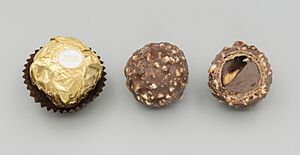Ferrero Rocher facts for kids
 |
|
 |
|
| Owner | Ferrero SpA |
|---|---|
| Introduced | 1979 |
Ferrero Rocher is a famous brand of chocolate and hazelnut candy. It is made by an Italian company called Ferrero. A person named Michele Ferrero created this delicious treat.
Each Ferrero Rocher candy is shaped like a ball. It is wrapped in shiny foil and sits in a small paper cup. These candies are made by machines, and many parts of how they are made are kept secret. Ferrero Rocher is sold all over the world. It is especially popular during the Christmas season.
Contents
History of Ferrero Rocher
Ferrero Rocher was first introduced in Italy in 1979. It then came to other parts of Europe in 1982. Michele Ferrero, who invented the chocolate, named it after a special place. He named it after a grotto, which is a small cave, at a shrine in Lourdes. The word Rocher comes from the French word for 'rock' or 'boulder'.
What's Inside a Ferrero Rocher?
A Ferrero Rocher has many tasty layers. It starts with a whole roasted hazelnut in the middle. This hazelnut is covered in a thin, crispy wafer shell. Inside the wafer, there is a creamy hazelnut chocolate filling. The whole candy is then covered in milk chocolate and sprinkled with chopped hazelnuts.
Main Ingredients
The ingredients in Ferrero Rocher include:
- Milk chocolate
- Sugar
- Cocoa butter
- Cocoa mass
- Skim milk powder
- Butteroil
- Lecithin (which helps mix things together)
- Vanillin (an artificial flavor)
- Hazelnuts
- Palm oil
- Wheat flour
- Whey (from milk)
- Low fat cocoa powder
- Sodium bicarbonate (which helps it rise)
- Salt
How Ferrero Rocher is Made
The way Ferrero Rocher is made is a big secret! No one is allowed to bring phones or notebooks into the factories. Only a few journalists have ever been invited to see the process. In 2015, the factory in Alba, Italy, made 24 million Ferrero Rochers every single day.
The process uses special machines. It starts with flat sheets of wafer that have little dome shapes. These domes are filled with a creamy chocolate hazelnut mix. Then, two wafer sheets are pressed together. One sheet has a hazelnut, and the other has the chocolate cream. The extra wafer is cut away, making perfect wafer balls. These balls are then coated with chocolate, then chopped hazelnuts, and finally another layer of milk chocolate. After all these steps, each chocolate ball is wrapped in its famous gold foil.
Where Ferrero Rocher is Sold
About 3.6 billion Ferrero Rochers are sold each year. You can find them in over 42 countries around the world. This includes many countries in Europe, Asia, Africa, the Americas, and Oceania.
Cultural Impact of Ferrero Rocher
Ferrero Rocher is more than just a chocolate; it has become part of different cultures.
Christmas and Holidays
Ferrero Rochers are strongly connected with the holiday season. People often buy them for Christmas and New Year. In 2015, more than half of all Ferrero Rochers were sold in the last three months of the year. This shows how popular they are during the holidays.
Famous 1990s Advertisement
In the 1990s, a very popular advertisement for Ferrero Rocher aired in the United Kingdom. It showed a fancy party at an ambassador's home. The chocolates were arranged in a tall pyramid, making them look like a very special treat. This advertisement became so famous that it has been copied and made fun of many times in movies and TV shows.
Popularity in Communities
Ferrero Rocher is also very popular among some communities in the United States. This is because it looks fancy and expensive, but it costs less than other luxury items. Before Ferrero Rocher was widely available in mainland China, people from Hong Kong would often give them as gifts. They even called the chocolates "gold sand" because of their shiny wrapper.
Dealing with Fake Products
Sometimes, companies try to make fake versions of popular products. In 2017, police found a factory making fake Ferrero Rocher chocolates. They seized 300,000 fake pieces. Ferrero has worked hard to stop companies from making these fake chocolates.
See also
 In Spanish: Ferrero Rocher para niños
In Spanish: Ferrero Rocher para niños




